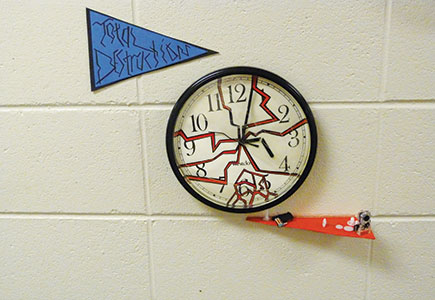 After-school installation from departing seniors.
After-school installation from departing seniors.
Exploring How Artists Use Space
Exploration with students can begin with the ways contemporary artists have looked at space in buildings and outside in the community as larger fields for playing and innovation. Students admire the feats and adventurous spirit of street artists such as Banksy, yarn-bombing artists, and JR. Students also enjoy the daring stories behind Guerilla art, and how artists such as Keri Smith alter environments. The secretive hide-and-seek aspects of street art appeals to students of all ages. Kiki Smith defines Guerilla art as “a fun and insidious way of sharing your vision with the world. It is a method of art making which entails leaving anonymous art pieces in a public place.”
Our Purpose
In our project, I emphasized to students that the purpose of our art was not to leave a permanent mark on the building, but to leave markers that generate a fresh awareness and, perhaps, a lasting impression on classmates, faculty, and the entire school community.
Altering the Space
Contemporary artists have used the architectural elements of museum spaces, showing art on the floor and constructing forms descending from the ceiling. Artists today draw directly on museum walls, and place their work in elevators, stairways, or restrooms. They reshape entrances or move audiences through mazes to reexperience being in a gallery. As a class, we walked around our building and students made suggestions about how each space could be altered. We Leaving Their Marks Ilona Szekely simply looked for meaningful spots to spend time, sit and think about what to say or what to place into each space.
After-School Installations
Like most K–12 schools, the art in our building has been placed on bulletin boards or protected inside glass cases. That was about to change. After school, students began to set up projects in the halls, bathrooms, lockers, and newly discovered areas. For example, an installation was placed in a stairwell using old textbooks chained and tied to the wall. Words taped to stairs unfolded poetic messages: “Even when you fall on your face, you are still moving forward.” The art melded into the experience of being there, available for interaction and comment.
Other student installations included whiteboard signs outside of studio classrooms where anyone could comment and doodle about the classes. An empty landing between floors became a cave, displaying parking lot cones and “Wet Floor” signs. Columns and poles were colorfully wrapped to become installations, and origami cats were strategically placed on different floors.
When students and faculty arrived the next morning, everyone began to see the spaces and surfaces that had become works of installation art. In the hallway conversations throughout the day, new ideas blossomed. There was talk of what could be done inside the cafeteria, in the library, at the school entrance, and which other structures in town would be perfect for alterations.
Reception
An interesting aspect of this project was the reception by students, faculty, and administrators. Our class became observers of the experience, since the artists who created the installations did not sign or advertise their contributions. By using comment cards and by just sitting and listening to peers, we could gauge the reaction over the next few days and weeks. A colleague stopped to tell me how excited he was to find geese by the door and that they were going to stay.
School art installations can challenge the notion of where art can exist. Art teachers can present art problems for recreating spaces and leaving creative marks everywhere. Thinking in terms of installations will lead your students to a fresh notion of art.
Ilona Szekely is professor of art education at Eastern Kentucky University. professor@ilonaszekely.com
View this article in the digital edition.


 After-school installation from departing seniors.
After-school installation from departing seniors.